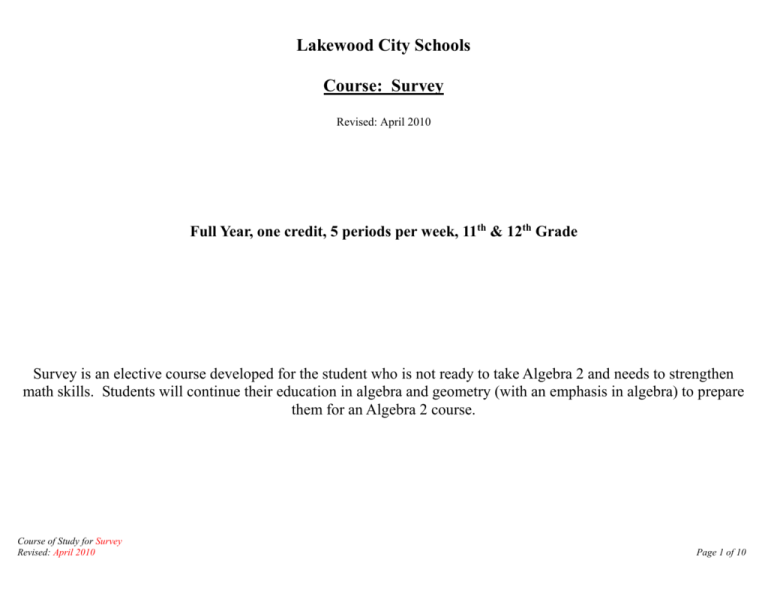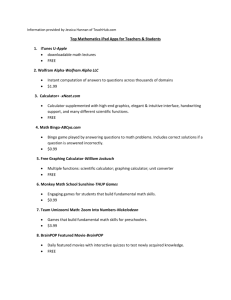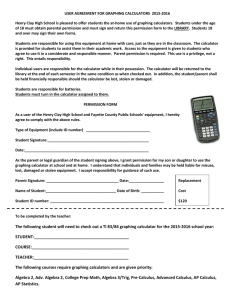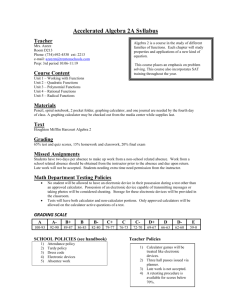Survey Algebra - Lakewood City Schools
advertisement

Lakewood City Schools Course: Survey Revised: April 2010 Full Year, one credit, 5 periods per week, 11th & 12th Grade Survey is an elective course developed for the student who is not ready to take Algebra 2 and needs to strengthen math skills. Students will continue their education in algebra and geometry (with an emphasis in algebra) to prepare them for an Algebra 2 course. Course of Study for Survey Revised: April 2010 Page 1 of 10 Lakewood City Schools Course: Survey Revised: April 2010 Pacing Chart ( Course of Study for Survey Revised: April 2010 UNIT 1: Introductory Topics 2 weeks UNIT 2: Basic Algebra 3 weeks UNIT 3: Ratios and Proportions 2 weeks UNIT 4: Linear Equations and Systems 4 weeks UNIT 5: Ratios and Measurements 2 weeks UNIT 6: Probability 3 weeks UNIT 7: Matrices 3 weeks UNIT 8: Quadratic Equations and Functions 5 weeks UNIT 9: Polynomials and Polynomial Functions 4 weeks UNIT 10: Radical Functions and Rational Exponents 4 weeks UNIT 11: Exponential and Logarithmic Functions 4 weeks Page 2 of 10 Lakewood City Schools Course of Study for Algebra 2 Revised: January 2009 Number, Number Sense and Operations Standard Standard and Benchmark A. Demonstrate that vectors and matrices are systems having some of the same properties of the real number system B. Develop an understanding of properties of representations for addition and multiplication of vectors and matrices C. Apply factorials and exponents, including fractional exponents, to solve practical problems D. Demonstrate fluency in operations with real numbers, vectors and matrices, using mental computation or paper and pencil calculations for simple cases and technology for more complicated cases Course of Study for Survey Revised: April 2010 Grade Level Indicators 11N1 Determine what properties hold for matrix addition and matrix multiplication; e.g., use examples to show addition is commutative and when multiplication is not commutative Clear Learning Targets I can… Strategies/Resources MM: 1-4, 1-5, 1-7, 1-8 PH Alg 2: 4-2, 4-3, 4-5 Technology: Graphing calculator 11N2 Determine what properties hold for vector addition and multiplication, and for scalar multiplication MM: 1-4, 1-5, 1-7, 1-8 PH Alg 2: 4-3, 4-4 Technology: Graphing calculator 11N1 Determine what properties hold for matrix addition and matrix multiplication; e.g., use examples to show addition is commutative and when multiplication is not commutative MM: 1-4, 1-5, 1-7, 1-8 PH Alg 2: 4-2, 4-3, 4-5 Technology: Graphing calculator 11N2 Determine what properties hold for vector addition and multiplication, and for scalar multiplication MM: 1-4, 1-5, 1-7, 1-8, 6-5, 6-6 PH Alg 2: 4-3, 4-4 Technology: Graphing calculator 11N5 Model, using the coordinate plane, vector addition and scalar multiplication PH Alg 2: 4-4 11N8 Use fractional and negative exponents as optional ways of representing and finding solutions for problem situations 11N4 Use matrices to represent given information in a problem situation 11N6 Compute sums, differences, and products and quotients of matrices using PH Alg 2: 7-1, 7-4, 7-5, 8-1, 8-2, 8-3, 8-4, 8-5 MM: 6-7 PH Alg 2: 4-2, 4-3, 4-4, 4-5 Technology: Graphing calculator PH Alg 2: 4-2, 4-3, 4-4, 4-5 Page 3 of 10 E. Represent and compute with complex numbers paper and pencil calculations for simple cases and technology for more complicated cases Technology: Graphing calculator 11N9 Use vector addition and scalar multiplication to solve problems PH Alg 2: 4-3, 4-4, 4-5 11N3 Represent complex numbers in the complex plane PH Alg 2: 5-6 PH Alg 2: 5-6, 5-8, 6-4, 6-5, 6-6 11N7 Compute sums, differences, products and quotients of complex numbers Course of Study for Survey Revised: April 2010 Page 4 of 10 Lakewood City Schools Course of Study for Algebra 2 Revised: January 2009 Measurement Standard Standard and Benchmark Grade Level Indicators Clear Learning Targets I can… Strategies/Resources A. Explain differences among accuracy , precision and error, and describe how each of those can affect solutions in measurement situations 11M1 Determine the number of significant digits in a measurement B. Apply various measurement scales to describe phenomena and solve problems 11M2 Use radian and degree measures to solve problems and perform conversions as needed 11M3 Derive a formula for the surface area of a cone as a function of its slant height and the circumference of its base MM: 5-1, 7-1, 7-2, 7-3 11M4 Calculate distances, areas, surface areas and volumes of composite threedimensional objects to a specified number of significant digits 11M5 Solve real-world problems involving area, surface area, volume and density to a specified degree of precision MM: 5-4 C. Estimate and compute areas and volume in increasingly complex problem situations D. Solve problem situations involving derived measurements Course of Study for Survey Revised: April 2010 MM: 1-8, 5-1, 9-7 MM: 2-2, 2-3, 5-2, 5-3, 5-4 PH Alg 2: 6-1, 6-4 MM: 2-2, 2-3, 2-4, 2-5, 5-1, 5-2, 5-4, 7-3, 97 PH Alg 2: 4-4, 7-2, 7-4, 7-5, 8-3, 8-5 Page 5 of 10 Lakewood City Schools Course of Study for Algebra 2 Revised: January 2009 Geometry and Spatial Sense Standard Standard and Benchmark Grade Level Indicators Clear Learning Targets Strategies/Resources I can… A. Use trigonometric relationships to verify and determine solutions in problem situations See Indicators for Geomety or Algebra 2 B. Represent transformations within a coordinate system using vectors and matrices 11G2 Represent translations using vectors PH Alg 2: 4-4, 5-3, 8-3 11G3 Describe multiplication of a vector and a scalar graphically and algebraically and apply to problem situations PH Alg 2: 4-3 Course of Study for Survey Revised: April 2010 Page 6 of 10 Course of Study for Algebra 2 Revised: January 2009 Patterns, Functions and Algebra Standard Standard and Benchmark Grade Level Indicators A. Analyze functions by investigating rates of change, intercepts, zeros, asymptotes and local and global behavior 11P3 Describe and compare the characteristics of the following families of functions: quadratics with complex roots, polynomials of any degree, logarithms, and rational functions; e.g, general shape, number of roots, domain and range, asymptote behavior I can… Strategies/Resources MM: 2-2, 2-3 PH Alg2: 5-1, 5-2, 5-3, 5-5, 5-8, 6-1, 6-2, 63, 6-4, 6-6, 8-1, 8-3, 8-6 Technology: Graphing calculator 11P4 Identify the maximum and minimum points of a polynomial, rational and trigonometric functions graphically and with technology PH Alg2: 5-1, 5-2, 6-2 Technology: Graphing calculator 11P5 Identify families of functions with graphs that have rotation symmetry or reflection symmetry about the y-axis, x-axis or y = x MM: 2-2, 2-3, 2-4, 2-5 PH Alg2: 4-4, 5-2, 6-1, 7-7, 7-8 Technology: Graphing calculator 11P6 Represent the inverse of a function symbolically and graphically as a reflection about y=x 11P11 Describe how a change in the value of a constant in an exponential, logarithmic or radical equation affects the graph of the equation Course of Study for Survey Revised: April 2010 Clear Learning Targets PH Alg2: 7-7, 7-8, 8-3, 8-6 PH Alg2: 7-8, 8-2, 8-3 Technology: Graphing calculator Page 7 of 10 B. Use the quadratic formula to solve quadratic equations that have complex roots 11P8 Solve equations involving radical expressions and complex roots C. Use recursive functions to model and solve problems 11P1 Identify and describe problem situations involving an iterative process that can be represented as a recursive formula; e.g., compound interest D. Apply algebraic methods to represent and generalize problem situations involving vectors and matrices Course of Study for Survey Revised: April 2010 PH Alg2: 5-6, 5-8, 6-4, 6-5, 6-6, 7-1, 7-3, 75 Technology: Graphing calculator MM: 2-4, 2-5 PH Alg2: 7-6 11P2 Translate a recursive function into a closed form expression or formula for the nth term to solve a problem situation involving an iterative process 11P7 Model and solve problems with matrices PH Alg2: 8-1, 8-2 11P9 Solve 3x3 systems of linear equations by elimination and using technology and interpret graphically what the solution means PH Alg2: 5-1 PH Alg2: 4-2, 4-3, 4-5 Page 8 of 10 Lakewood City Schools Course of Study for Algebra 2 Revised: January 2009 Data Analysis and Probability Standard Standard and Benchmark Grade Level Indicators A. Create and analyze tabular and graphical displays of data using appropriate tools, including spreadsheets and graphing calculators 11D4 Create a scatterplot of bivariate data, identify trends, and find a function to model the data 11D5 Use technology to find the Least Squares Regression Line, the regression coefficient, and the correlation coefficient for bivariate data with a linear trend, and interpret each of these statistics in the context of the problem situation B. Use descriptive statistics to analyze and summarize data, including measures of center, dispersion, correlation and variability Course of Study for Survey Revised: April 2010 Clear Learning Targets I can… Strategies/Resources MM: 6-4, 9-6 PH Alg 2: 5-1, 6-1, 8-1 Technology: Graphing calculator MM: 9-6 Technology: Graphing calculator 11D8 Analyze and interpret univariate and bivariate data to identify patterns, note trends, draw conclusions and make predicitions MM: 2-6, 9-1, 9-2, 9-3, 9-4, 9-6, 9-7 PH Alg 2: 4-2, 6-7 Technology: Graphing calculator 11D10 Understand and use the concept of random variable and compute and interpret the expected value for a random variable in simple cases 11D3 Describe how a linear transformation of univariate data affects range, mean, mode, and median MM: 9-3, 9-4 11D5 Use technology to find the Least Squares Regression Line, the regression coefficient, and the correlation coefficient for bivariate data with a linear trend, and interpret each of these statistics in the context of the problem situation MM: 9-6 Technology: Graphing calculator MM: 9-7 Page 9 of 10 C. Design and perform a statistical experiment, simulation or study; collect and interpret data; and use descriptive statistics to communicate and support predications and conclusions D. Connect statistical techniques to applications and consumer situations Course of Study for Survey Revised: April 2010 11D6 Use technology to compute the standard deviation for a set of data and interpret standard deviation in relation to the context or problem situation MM: 9-7 Technology: Graphing calculator 11D8 Analyze and interpret univariate and bivariate data to identify patterns, note trends, draw conclusions, and make predictions MM: 2-6, 9-1, 9-2, 9-3, 9-4, 9-5, 9-6, 9-7 PH Alg 2: 4-2, 6-7 Technology: Graphing calculator 11D1 Design a statistical experiment, survey or study for a problem; collect data for the problem; interpret data with appropriate graphical displays, descriptive statistics, concepts of variability, causation, correlation and standard deviation MM: 9-1, 9-2, 9-4, 9-5, 9-7 PH Alg 2: 6-7 Technology: Graphing calculator 11D9 Evaluate validity of results of a study based on characteristics of the study design, including sampling method, summary statistics and data analysis techniques MM: 9-7 PH Alg 2: 5-1 11D1 Design a statistical experiment, survey or study for a problem; collect data for the problem; interpret data with appropriate graphical displays, descriptive statistics, concepts of variability, causation, correlation and standard deviation MM: 9-1, 9-2, 9-5, 9-6, 9-7 PH Alg 2: 6-7 11D9 Evaluate validity of results of a study based on characteristics of the study design, including sampling method, summary statistics and data analysis techniques MM: 9-1, 9-2, 9-7 PH Alg 2: 5-1 11D11 Examine statements and decisions involving risk; e.g., insurance rates and medical decisions MM: 9-3, 9-4 Page 10 of 10








